Chapter 8
AERIAL PHOTOGRAPHS
An aerial photograph is any photograph taken from an airborne vehicle (aircraft, drones, balloons, satellites, and so forth). The aerial photograph has many uses in military operations; however, for the purpose of this manual, it will be considered primarily as a map supplement or map substitute.
8-1. COMPARISON WITH MAPS
A topographic map may be obsolete because it was compiled many years ago. A recent aerial photograph shows any changes that have taken place since the map was made. For this reason, maps and aerial photographs complement each other. More information can be gained by using the two together than by using either alone.
a. Advantages. An aerial photograph has the following advantages over a map:
(1) It provides a current pictorial view of the ground that no map can equal.
(2) It is more readily obtained. The photograph may be in the hands of the user within a few hours after it is taken; a map may take months to prepare.
(3) It may be made for places that are inaccessible to ground soldiers.
(4) It shows military features that do not appear on maps.
(5) It can provide a day-to-day comparison of selected areas, permitting evaluations to be made of enemy activity.
(6) It provides a permanent and objective record of the day-to-day changes with the area.
b. Disadvantages. The aerial photograph has the following disadvantages as compared to a map:
(1) Ground features are difficult to identify or interpret without symbols and are often obscured by other ground detail as, for example, buildings in wooded areas.
(2) Position location and scale are only approximate.
(3) Detailed variations in the terrain features are not readily apparent without overlapping photography and a stereoscopic viewing instrument.
(4) Because of a lack of contrasting colors and tone, a photograph is difficult to use in poor light.
(5) It lacks marginal data.
(6) It requires more training to interpret than a map.
8-2. TYPES
Aerial photography most commonly used by military personnel may be divided into two major types, the vertical and the oblique. Each type depends upon the attitude of the camera with respect to the earth’s surface when the photograph is taken.
a. Vertical. A vertical photograph is taken with the camera pointed as straight down as possible (Figures 8-1 and 8-2). Allowable tolerance is usually + 3° from the perpendicular (plumb) line to the camera axis. The result is coincident with the camera axis. A vertical photograph has the following characteristics:
(1) The lens axis is perpendicular to the surface of the earth.
(2) It covers a relatively small area.
(3) The shape of the ground area covered on a single vertical photo closely approximates a square or rectangle.
(4) Being a view from above, it gives an unfamiliar view of the ground.
(5) Distance and directions may approach the accuracy of maps if taken over flat terrain.
(6) Relief is not readily apparent.
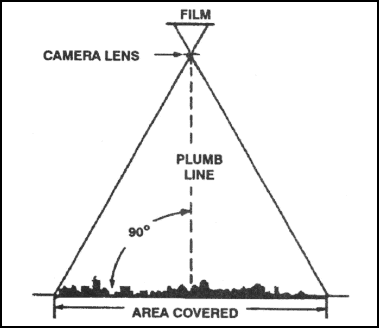
Figure 8-1. Relationship of the vertical aerial photograph with the ground.
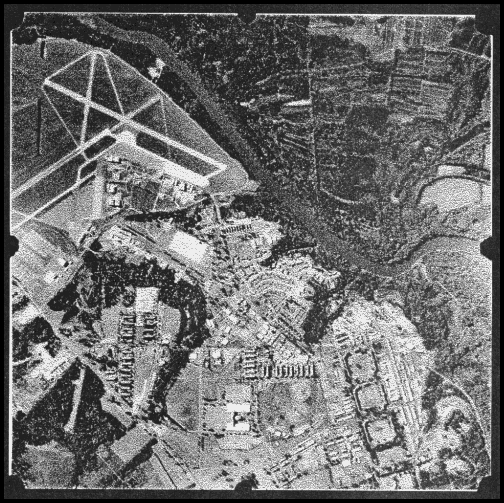
Figure 8-2. Vertical photograph.
a. Low Oblique. This is a photograph taken with the camera inclined about 30° from the vertical (Figure 8-3, and Figure 8-4). It is used to study an area before an attack, to substitute for a reconnaissance, to substitute for a map, or to supplement a map. A low oblique has the following characteristics:
(1) It covers a relatively small area.
(2) The ground area covered is a trapezoid, although the photo is square or rectangular.
(3) The objects have a more familiar view, comparable to viewing from the top of a high hill or tall building.
(4) No scale is applicable to the entire photograph, and distance cannot be measured. Parallel lines on the ground are not parallel on this photograph; therefore, direction (azimuth) cannot be measured.
(5) Relief is discernible but distorted.
(6) It does not show the horizon.

Figure 8-3. Relationship of low oblique photograph to the ground.
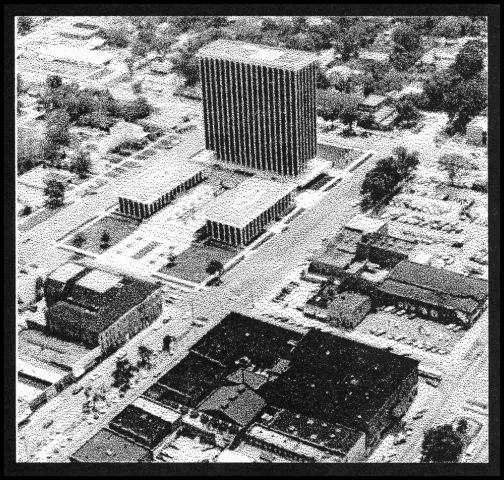
Figure 8-4. Low oblique photograph.
c. High Oblique. The high oblique is a photograph taken with the camera inclined about 60° from the vertical (Figures 8-5 and 8-6). It has a limited military application; it is used primarily in the making of aeronautical charts. However, it may be the only photography available. A high oblique has the following characteristics:
(1) It covers a very large area (not all usable).
(2) The ground area covered is a trapezoid, but the photograph is square or rectangular.
(3) The view varies from the very familiar to unfamiliar, depending on the height at which the photograph is taken.
(4) Distances and directions are not measured on this photograph for the same reasons that they are not measured on the low oblique.
(5) Relief may be quite discernible but distorted as in any oblique view. The relief is not apparent in a high altitude, high oblique.
(6) The horizon is always visible.
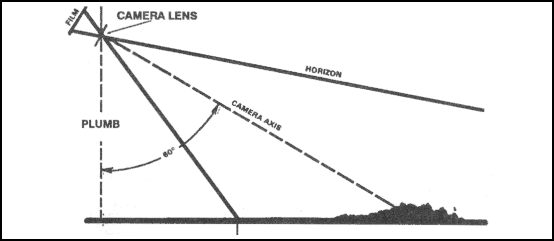
Figure 8-5. Relationship of high oblique photograph to the ground.
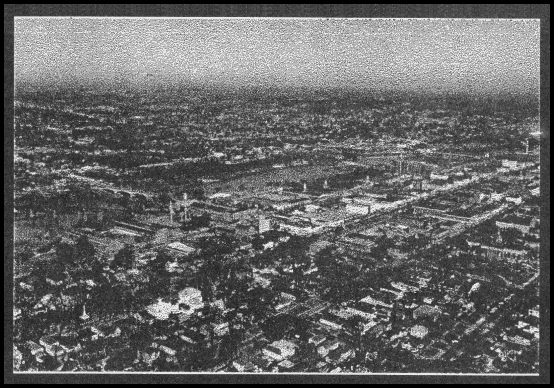
Figure 8-6. High oblique photograph.
d. Trimetrogon. This is an assemblage of three photographs taken at the same time, one vertical and two high obliques, in a direction at right angle to the line of flight. The obliques, taken at an angle of 60° from the vertical, sidelap the vertical photography, producing composites from horizon to horizon (Figure 8-7).
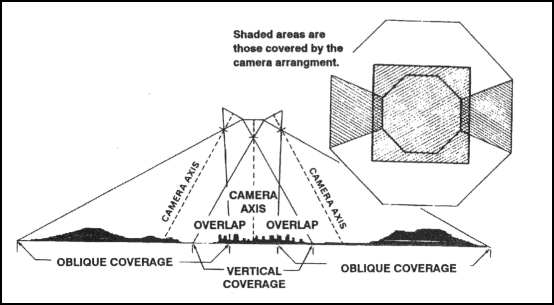
Figure 8-7. Relationship of cameras to ground for trimetrogon photography (three cameras).
e. Multiple Lens Photography. These are composite photographs taken with one camera having two or more lenses, or by two or more cameras. The photographs are combinations of two, four, or eight obliques around a vertical. The obliques are rectified to permit assembly as verticals on a common plane.
f. Convergent Photography. These are done with a single twin-lens, wide-angle camera, or with two single-lens, wide-angle cameras coupled rigidly in the same mount so that each camera axis converges when intentionally tilted a prescribed amount (usually 15 or 20°) from the vertical. Again, the cameras are exposed at the same time. For precision mapping, the optical axes of the cameras are parallel to the line of flight, and for reconnaissance photography, the camera axes are at high angles to the line of flight.
g. Panoramic. The development and increasing use of panoramic photography in aerial reconnaissance has resulted from the need to cover in greater detail more and more areas of the world.
(1) To cover the large areas involved, and to resolve the desired ground detail, present-day reconnaissance systems must operate at extremely high-resolution levels. Unfortunately, high-resolution levels and wide-angular coverage are basically contradicting requirements.
(2) A panoramic camera is a scanning type of camera that sweeps the terrain of interest from side to side across the direction of flight. This permits the panoramic camera to record a much wider area of ground than either frame or strip cameras. As in the case of the frame cameras, continuous cover is obtained by properly spaced exposures timed to give sufficient overlap between frames. Panoramic cameras are most advantageous for applications requiring the resolution of small ground detail from high altitudes.
8-3. TYPES OF FILM
Types of film generally used in aerial photography include panchromatic, infrared, and color. Camouflage detection film is also available.
a. Panchromatic. This is the same type of film that is used in the average hand-held small camera. It records the amount of light reflected from objects in tones of gray running from white to black. Most aerial photography is taken with panchromatic film.
b. Infrared. This is a black-and-white film that is sensitive to infrared waves. It can be used to detect artificial camouflage materials and to take photographs at night if there is a source of infrared radiation.
c. Color. This film is the same as that used in the average hand-held camera. It is limited in its use because of the time required to process it and its need for clear, sunny weather.
d. Camouflage Detection. This film is a special type that records natural vegetation in a reddish color. When artificial camouflage materials are photographed, they appear bluish or purplish. The name of this film indicates its primary use.
8-4. NUMBERING AND TITLING INFORMATION
Each aerial photograph contains in its margin important information for the photo user. The arrangement, type, and amount of this information is standardized; however, the rapid development of cameras, film, and aeronautical technology since World War II has caused numerous changes in the numbering and titling of aerial photographs. As a result, the photo user may find that the marginal information on older photographs varies somewhat from the standard current practice. With certain camera systems, some of the data are automatically recorded on each exposure, while other systems require that all titling data be added to the film after processing.
a. Standard titling data for aerial photography prepared for the use of the Department of Defense are as follows. For reconnaissance and charting photography, items 2 through 14 and item 19 are lettered on the beginning and end of each roll of film. Items 1 through 9 and item 19 are lettered on each exposure. For surveying and mapping photography, items 2 through 19 are lettered on the beginning and end of each roll of film, and items 1, 2, 3, 5, 6, 7, 8, 9, 13, and 19 are lettered on each exposure.
(1) Negative number.
(2) Camera position.
(3) Taking unit.
(4) Service.
(5) Sortie/mission number.
(6) Date (followed by a double hyphen [=]).
(7) Time group and zone letter (GMT).
(8) Focal length.
(9) Altitude.
(10) Kind of photography or imagery.
(11) Geographic coordinates.
(12) Descriptive title.
(13) Project number and or name.
(14) Camera type and serial number.
(15) Cone serial number (if any).
(16) Lens type and serial number.
(17) Magazine type and serial number.
(18) Type of photographic filter used.
(19) Security classification.
b. Automatically recorded data may differ somewhat in arrangement from the sequence listed above, but the same information is available to the photo user. A detailed explanation of the titling items and the codes used to indicate them is found in TM 5-243.
8-5. SCALE DETERMINATION
Before a photograph can be used as a map supplement or substitute, it is necessary to know its scale. On a map, the scale is printed as a representative fraction that expresses the ratio of map distance to ground distance, For example:
RF
=
MD
——
GD
On a photograph, the scale is also expressedas a ratio, but is the ratio of the photo distance (PD) to ground distance.For example:
RF
=
PD
——
GD
The approximate scale or average scale (RF) of a vertical aerial photograph is determined by either of two methods; the comparison method or the focal length-flight altitude method.
a. Comparison Method. The scale of a vertical aerial photograph is determined by comparing the measured distance between two points on the photograph with the measured ground distance between the same two points.
SCALE (RF
=
Photo Distance
————————
Ground Distance
The ground distance is determined by actual measurement on the ground or by the use of the scale on a map of the same area. The points selected on the photograph must be identifiable on the ground or map of the same area and should be spaced in such a manner that a line connecting them will pass through or nearly through the center of the photograph (Figure 8-8).
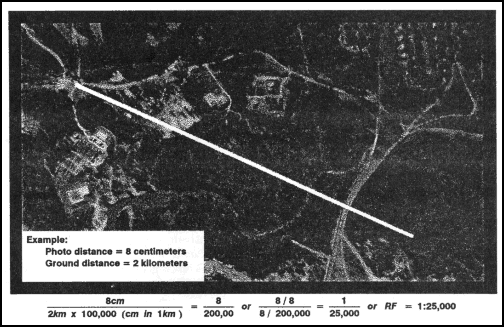
Figure 8-8. Selection of points for scale determination.
b. Focal Length-Flight Altitude Method. When the marginal information of a photograph includes the focal length and the flight altitude, the scale of the photo is determined using the following formula (Figure 8-9).
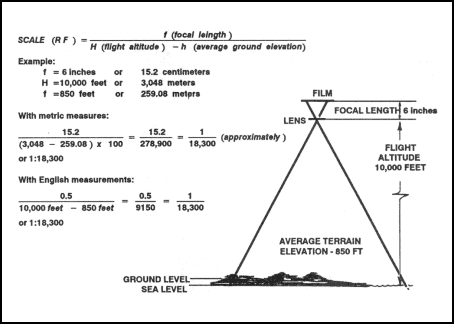
Figure 8-9. Computation of scale from terrain level.
When the ground elevation is at sea level, H becomes zero, and the formula is as shown in Figure 8-10.
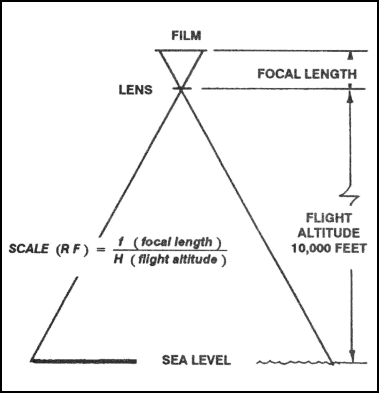
Figure 8-10. Basic computation of scale from sea level.
8-6. INDEXING
When aerial photos are taken of an area, it is convenient to have a record of the extent of coverage of each photo. A map on which the area covered by each photo is outlined and numbered or indexed to correspond to the photo is called an index map. There are two methods of preparing index maps.
a. The four-corner method (Figures 8-11 and 8-12) requires location on the map of the exact point corresponding to each corner of the photo. If a recognizable object such as a house or road junction can be found exactly at one of the corners, this point may be used on the map as the corner of the photo. If recognizable objects cannot be found at the corners, then the edges of the photo should be outlined on the map by lining up two or more identifiable objects along each edge; the points where the edges intersect should be the exact corners of the photo. If the photo is not a perfect vertical, the area outlined on the map will not be a perfect square or rectangle. After the four sides are drawn on the map, the number of the photograph is written in the enclosed area for identification. This number should be placed in the same corner as it is on the photo.
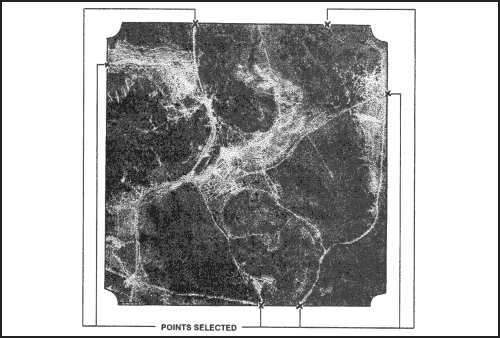
Figure 8-11. Four-corner method (selection of points).
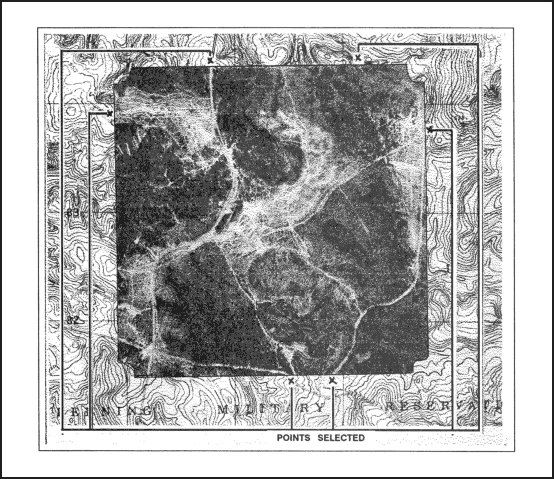
Figure 8-12. Plotting, using the four-corner method.
b. The template method is used when a large number of photos are to be indexed, and the exact area covered by each is not as important as approximate area and location. In this case, a template (cardboard pattern or guide) is cut to fit the average area the photos cover on the index map. It is used to outline the individual area covered by each photo. To construct a template, find the average map dimensions covered by the photos to be indexed as follows. Multiply the average length of the photos by the denominator of the average scale of the photos; multiply this by the scale of the map. Do the same for the width of the photos. This gives the average length and width of the area each photo covers on the map–or the size to which the template should be cut (Figure 8-13).
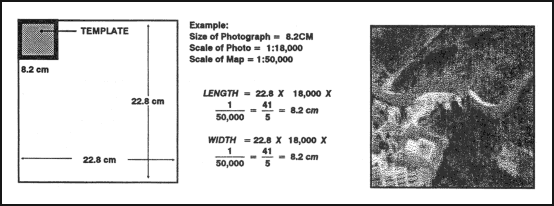
Figure 8-13. Constructing a template.
c. To index the map, select the general area covered by the first photo and orient the photo to the map. Place the template over the area on the map and adjust it until it covers the area as completely and accurately as possible. Draw lines around the edges of the template. Remove the rectangle and proceed to the next photo (Figure 8-14).
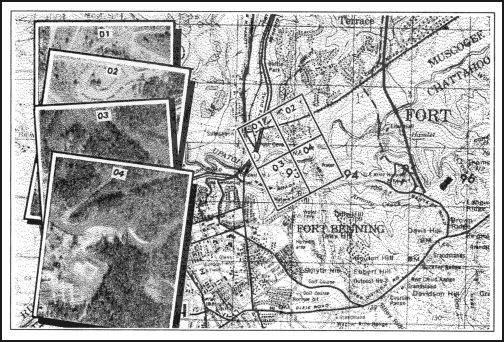
Figure 8-14. Indexing with a template.
d. After all photos have been plotted, write on the map sufficient information to identify the mission or sortie. If more than one sortie is plotted on one map or overlay, use a different color for each sortie.
e. In most cases, when a unit orders aerial photography, an index is included to give the basic information. Instead of being annotated on a map of the area, it appears on an overlay and is keyed to a map.
8-7. ORIENTING OF PHOTOGRAPH
Orienting the photograph is important because it is of very little value as a map supplement or substitute if its location and direction are not known by the user.
a. If a map of the same area as the photograph is available, the photograph is oriented to the map by comparing features common to both and then transferring a direction line from the map to the photograph.
b. If no map is available, the shadows on a photograph may be used to get an approximate true-north line. This method is not recommended in the torrid zone (Figure 8-15).
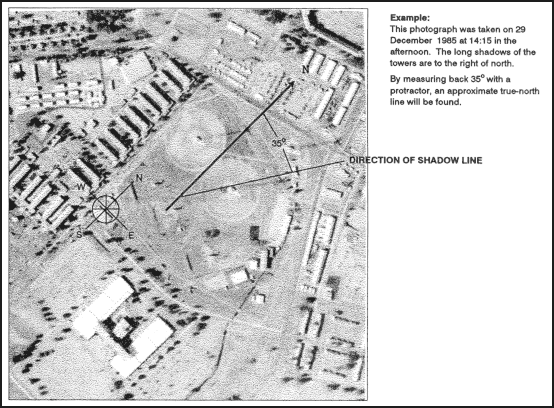
Figure 8-15. Using shadows on a photograph to find north.
(1) North Temperate Zone. The sun moves from the east in the morning through south at noon to west in the afternoon. Conversely, shadow fall varies from west through north to east. Before noon, therefore, north is to the right of the direction of shadow fall; at noon, north is the direction of shadow fall; and after noon, north is to the left of shadow fall. On an average, the amount of variation in shadow fall per hour is 15 degrees. From marginal information, determine the number of hours from noon that the photo was taken and multiply that number by 15°. With a protractor, measure an angle of that amount in the proper direction (right to left) from a clear, distinct shadow, and north is obtained. For photographs taken within three hours of noon, a reasonable accurate north direction can be obtained. Beyond these limits, the 15° must be corrected, depending on time of year and latitude.
(2) South Temperate Zone. The sun moves from east through north at noon to west. Shadows then vary from west through south to east. Before noon, south is to the left of shadow fall; at noon, south is shadow fall; and after noon, south is to the right of shadow fall. Proceed as in (1) above to determine the direction of south.
c. On a photograph that can be oriented to the surrounding ground features by inspection, a magnetic-north line can be established using a compass.
(1) Orient the photograph by inspection.
(2) Open the compass and place it on the photograph.
(3) Without moving the photograph, rotate the compass until the north arrow is under the stationary black line.
(4) Draw a line along the straight edge of the compass. This is a magnetic-north line.
8-8. POINT DESIGNATION GRID
Since aerial photographs are seldom exactly the same scale as a map of the same area, it is not feasible to print military grids on them. A special grid is used for the designation of points on photographs (Figure 8-16). This grid, known as the point designation grid, has no relation to the scale of the photo, to any direction, or to the grid used on any other photograph or map. It has only one purpose, to designate points on photographs.
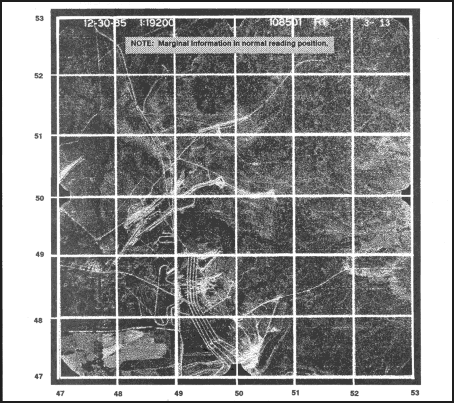
Figure 8-16. Point designation grid.
a. The point designation grid is rarely printed on photographs; therefore, it becomes the responsibility of each user to construct the grid on the photograph. All users must construct the grid in exactly the same way. Before the grid can be constructed or used, the photograph must be held so that the marginal information, regardless of where it is located, is in the normal reading position (Figure 8-17, step 1).
(1) Draw lines across the photograph joining opposite reference marks at the center of each photograph (fiducial marks). If there are no fiducial marks, the center of each side of the photograph is assumed to be the location of the marks (Figure 8-17, step 2).
(2) Space grid lines, starting with the center line, 4 centimeters (1.575 inches) apart (a distance equal to 1,000 meters at a scale of 1:25,000). The 1:25,000 map coordinate scale can be used for this dimension and to accurately designate points on the photograph, but this does not mean that distance can be scaled from the photograph. Extend the grid past the margins of the photograph so that a horizontal and vertical grid line fall outside the picture area (Figure 8-17, step 3).
(3) Number each center line “50” and give numerical values to the remaining horizontal and vertical lines so that they increase to the right and up (Figure 8-17, step 4).
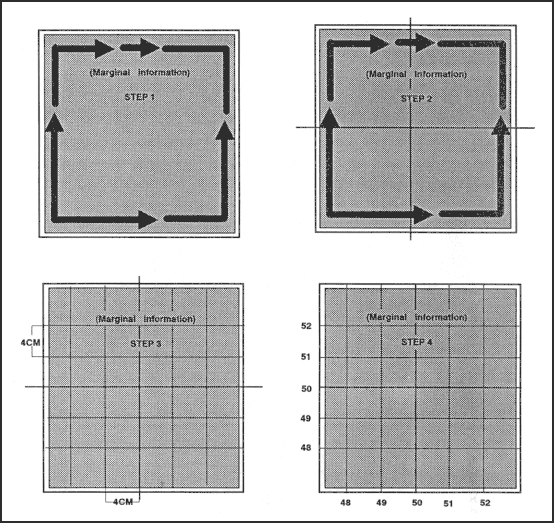
Figure 8-17. Constructing a point designation grid.
b. The point designation grid is used, once the photograph is oriented, in the same manner as the grid on a map (Figure 8-18), read right and up. The coordinate scale used with the UTM grid on maps at the scale of 1:25,000 may be used to subdivide the grid square in the same manner as on a map. However, because the same point designation grid is used on all photographs, the coordinates of a point on the photograph must be prefixed by the identifying marginal information of the photograph.
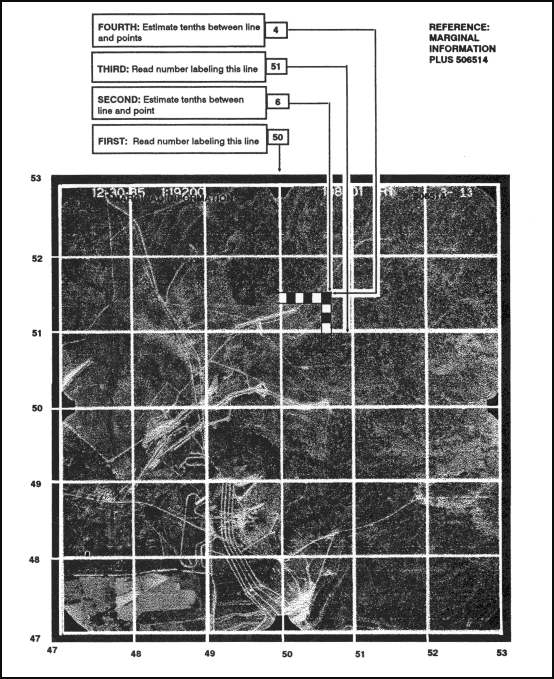
Figure 8-18. Reading point designation grid coordinates.
c. A grid coordinate using the point designation grid (Figure 8-19) consists of three parts:
(1) The letters “PDG” to indicate an aerial photograph rather than a map grid coordinate.
(2) The mission and photo negative number to identify which photograph is being used.
(3) The six numerical digits to locate the actual point on the photograph.
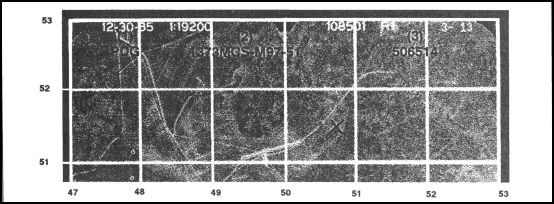
Figure 8-19. Locating the grid coordinate on a point designation grid.
8-9. IDENTIFICATION OF PHOTOGRAPH FEATURES
The identification of features on a photograph is not difficult if the following facts are remembered. The view that is presented by the aerial photograph is from above and, as a result, objects do not look familiar. Objects that are greatly reduced in size appear distorted. Most aerial photography is black and white, and all colors appear on the photograph in shades of gray. Generally speaking, the darker the natural color, the darker it will appear on the photograph.
a. The identification of features on aerial photographs depends upon a careful application of five factors of recognition. No one factor will give a positive identification; it requires the use of all five.
(1) Size. The size of unknown objects on a photograph, as determined from the scale of the photograph or a comparison with known objects of known size, gives a clue to their identity. For example, in a built-up area the smaller buildings are usually dwellings, and the larger buildings are commercial or community buildings.
(2) Shape (Pattern). Many features possess characteristic shapes that readily identify the features. Man-made features appear as straight or smooth curved lines, while natural features usually appear to be irregular. Some of the most prominent man-made features are highways, railroads, bridges, canals, and buildings. Compare the regular shapes of these to the irregular shapes of such natural features as streams and timber lines.
(3) Shadows. Shadows are very helpful in identifying features since they show the familiar side view of the object. Some excellent examples are the shadows of water towers or smoke stacks. As viewed directly from above, only a round circle or dot is seen, whereas the shadow shows the profile and helps to identify the object. Relative lengths of shadows also usually give a good indication of relative heights of objects.
(4) Shade (Tone or Texture). Of the many different types of photographic film in use today, the film used for most aerial photography, except for special purposes, is panchromatic film. Panchromatic film is sensitive to all the colors of the spectrum; it registers them as shades of gray, ranging from white to black. This lighter or darker shade of features on aerial photographs is known as the tone. The tone is also dependent on the texture of the features; a paved highway has a smooth texture and produces an even tone on the photograph, while a recently plowed field or a marsh has a rough, choppy texture and results in a rough or grainy tone. It is also important to remember that similar features may have different tones on different photographs, depending on the reflection of sunlight. For example, a river or body of water appears light if it is reflecting sunlight directly toward the camera, but appears dark otherwise. Its texture may be smooth or rough, depending on the surface of the water itself. As long as the variables are kept in mind, tone and texture may be used to great advantage.
(5) Surrounding Objects. Quite often an object not easily recognized by itself may be identified by its relative position to surrounding objects. Large buildings located beside railroads or railroad sidings are usually factories or warehouses. Identify schools by the baseball or football fields. It would be hard to tell the difference between a water tower next to a railroad station and a silo next to a barn, unless the surrounding objects such as the railroad tracks or cultivated fields were considered.
b. Before a vertical photograph can be studied or used for identification of features, it must be oriented. This orienting is different from the orienting required for the construction or use of the point designation grid. Orienting for study consists of rotating the photograph so that the shadows on the photograph point toward yourself. You then face a source of light. This places the source of light, an object, and its shadow in a natural relationship. Failure to orient a photograph properly may cause the height or depth of an object to appear reversed. For example, a mine or quarry may appear to be a hill instead of a depression.
8-10. STEREOVISION
One of the limitations of the vertical aerial photograph is the lack of apparent relief. Stereoscopic vision (or as it is more commonly known, stereovision or depth perception) is the ability to see three-dimensionally or to see length, width, and depth (distance) at the same time. This requires two views of a single object from two slightly different positions. Most people have the ability to see three-dimensionally. Whenever an object is viewed, it is seen twice–once with the left eye and once with the right eye. The fusion or blending together of these two images in the brain permits the judgment of depth or distance.
a. In taking aerial photographs, it is rare for only a single picture to be taken. Generally, the aircraft flies over the area to be photographed taking a series of pictures, each of which overlaps the photograph preceding it and the photograph following it so that an unbroken coverage of the area is obtained (Figure 8-20). The amount of overlap is usually 56 percent, which means that 56 percent of the ground detail appearing on one photo also appears on the next photograph. When a single flight does not give the necessary coverage of an area, additional flights must be made. These additional flights are parallel to the first and must have an overlap between them. This overlap between flights is known as side lap and usually is between 15 and 20 percent (Figure 8-21).
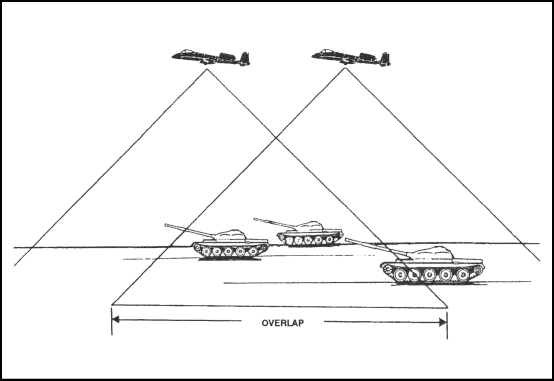
Figure 8-20. Photographic overlap.
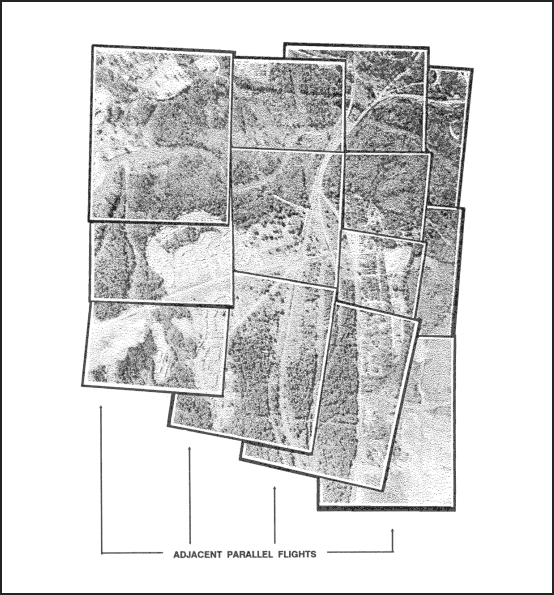
Figure 8-21. Side lap.
b. The requirement for stereovision can be satisfied by overlapping photographs if one eye sees the object on one photograph and the other eye sees the same object on another photograph. While this can be done after practice with the eyes alone, it is much easier if an optical aid is used. These optical aids are known as stereoscopes. There are many types of stereoscopes, but only the two most commonly used are discussed in this manual.
(1) Pocket Stereoscope. The pocket stereoscope (Figure 8-22), sometimes known as a lens stereoscope, consists of two magnifying lenses mounted in a metal frame. Because of its simplicity and ease of carrying, it is the type used most frequently by military personnel.
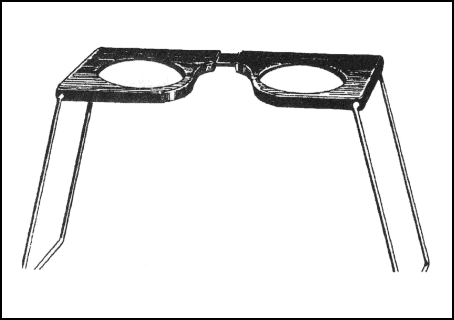
Figure 8-22. Pocket stereoscope.
(2) Mirror Stereoscope. The mirror stereoscope (Figure 8-23) is larger, heavier, and more subject to damage than the pocket stereoscope. It consists of four mirrors mounted in a metal frame.
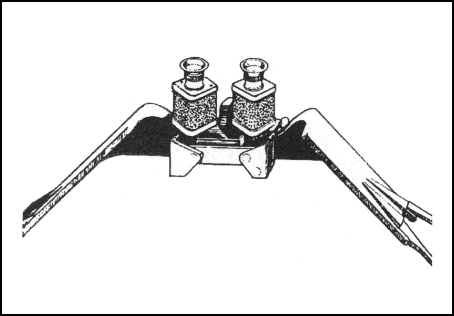
Figure 8-23. Mirror stereoscope.
c. A method to orient a pair of aerial photographs for best three-dimensional viewing is outlined below:
(1) Arrange the selected pair of photos in such a way that the shadows on them generally appear to fall toward the viewer. It is also desirable that the light source enters the side away from the observer during the study of the photographs (Figure 8-24).
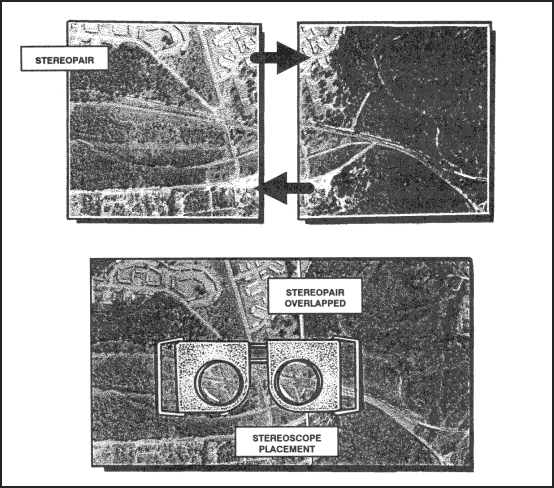
Figure 8-24. Placement of stereoscope over stereopair.
(2) Place the pair of photographs on a flat surface so that the detail on one photograph is directly over the same detail on the other photograph (Figure 8-24).
(3) Place the stereoscope over the photographs so that the left lens is over the left photograph and the right lens is over the right photograph (Figure 8-24).
(4) Separate the photographs along the line of flight until a piece of detail appearing in the overlap area of the left photograph is directly under the left lens and the same piece of detail on the right photo is directly under the right lens.
(5) With the photograph and stereoscope in this position, a three-dimensional image should be seen. A few minor adjustments may be necessary, such as adjusting the aerial photographs of the stereoscope to obtain the correct position for your eyes. The hills appear to rise and the valleys sink so that there is the impression of being in an aircraft looking down at the ground.
(6) The identification of features on photographs is much easier and more accurate with this three-dimensional view. The same five factors of recognition (size, shape, shadow, tone, and surrounding objects) must still be applied; but now, with the addition of relief, a more natural view is seen.
Land Navigation Training Software
- Chapter 1: TRAINING STRATEGY
- Chapter 2: MAPS
- Chapter 3: MARGINAL INFORMATION AND SYMBOLS
- Chapter 4: GRIDS
- Chapter 5: SCALE AND DISTANCE
- Chapter 6: DIRECTION
- Chapter 7: OVERLAYS
- Chapter 8: AERIAL PHOTOGRAPHS
- Chapter 9: NAVIGATION EQUIPMENT AND METHODS
- Chapter 10: ELEVATION AND RELIEF
- Chapter 11: TERRAIN ASSOCIATION
- Chapter 12: MOUNTED LAND NAVIGATION
- Chapter 13: NAVIGATION IN DIFFERENT TYPES OF TERRAIN
- Chapter 14: UNIT SUSTAINMENT
- Appendix A: FIELD SKETCHING
- Appendix B: MAP FOLDING TECHNIQUES
- Appendix C: UNITS OF MEASURE AND CONVERSION FACTORS
- Appendix D: JOINT OPERATIONS GRAPHICS
- Appendix E: EXPORTABLE TRAINING MATERIAL
- Appendix F: ORIENTEERING
- Appendix G: M2 COMPASS
- Appendix H: ADDITIONAL AIDS
- Appendix I: FOREIGN MAPS
- Appendix J: GLOBAL POSITIONING SYSTEM
- Appendix K: PRECISION LIGHTWEIGHT GLOBAL POSITIONING SYSTEM RECEIVER
- Map Reading and Land Navigation GLOSSARY
- Map Reading and Land Navigation REFERENCES